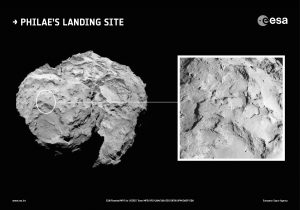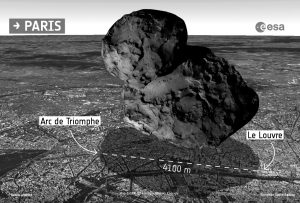Weston Honicker, Contributing Writer
I interviewed Dr. Joshua Nollenberg, Cosmologist and Professor of Astronomy at Oneonta State College, on Monday, November 18. I wanted to find out more about the European Space Agency’s mission to place a lander, Philae, on comet Churyumov-Gerasimenko. We talked at length. What follows is a shortened transcript.

Honicker: Comets—what are they and why are they important?
Nollenberg: Comets are basically the leftover debris from the formation of the solar system. When the solar system formed, planets, asteroids and comets all formed out of a disk of gas and dust circling around the proto-sun. In the outskirts of the solar system it was possible for comets to form out of volatile gasses—materials that can’t be found in the inner solar system.
H: What is the difference between the inner and outer solar system?
N: The inner solar system is closer to the sun and is where the temperature is highest, in the solar system. Things that can exist in the inner solar system are rocks, some liquids—it’s difficult for water to remain liquid if it is too close to the sun. Volatile materials, gasses such as hydrogen and helium, can literally evaporate. If you are far enough away from the sun, there isn’t much radiation from the sun reaching you—enough radiation to heat up these materials—and it is possible for these gasses to freeze and condense. And comets formed out of the condensation of these materials (volatiles, dust, complex hydrocarbons and some rock).
H: What is the boundary between the inner and outer solar system?
N: Somewhere between the orbit of Mars and Jupiter.
H: If we wanted to learn more about the history of life in the solar system, would we look to comets?
N: One way to explore the history of life in the solar system is to look to places where there are hydrocarbons, where there is organic chemistry. It happens that on comets and other objects in the outer solar system, such as Saturn’s moon Titan, there exists rich organic chemistry. Some people have come up with the idea of transpermia—where comets might be a way of depositing the chemicals necessary on a planetary surface to give rise to life. Early in the solar system there were many more cometary impacts than there are today, because there were lots more debris in the solar system as the planets were building up. This is the process of accretion.
H: What is the Rosetta mission, who is conducting it and when did it begin?
N: The Rosetta mission is run primarily by the European Space Agency, although NASA is involved with a couple of instruments. The project began in the late 90s, and the vehicle was originally intended for a different comet. Launch delays and budget delays caused a change. The comet is Churyumov-Gerasimenko. (If you can say it, you might as well.) That comet was picked because it has an orbit that doesn’t go too far out of the solar system. In order to catch up with this particular comet, we had to use three gravitational assists—where the gravity of a planet actually boosts the speed of a rocket from the Earth and one from Mars. And we caught up with the rocket when it was just past its most distant point from the Sun,so that the angle was best.
H:That’s when the comet was moving slowest?
N: That’s when it was moving slowest and otherwise, if we were trying to catch up with the comet when it was already in the inner solar system, it would be really difficult—you would need a booster that would have to go faster than anything we’ve got. On the other hand, this also gave a nice possibility for the mission design. If Rosetta would land a lander on the comet and orbit around the comet, the lander would be able to take samples periodically as the comet neared the sun to see what sort of changes took place above the surface also underneath the surface. And in addition, the orbiter would be able to map out the surface and see where plumes of gas and dust would be ejected. Using magnetometers, the orbiter could test for how these plumes affected the local environment.
H: About ten years have elapsed since the vehicle was launched. How were scientists able to direct the vehicle to this specific comet?
N: That’s actually pretty complicated. What you do is you make a couple of approximations. One, have an idea of when you want to get to the comet. Then, you look at all of the different possible orbits that will get you to that location. First off, you need enough lead time to fly and you also need enough lead time to be able to do the calculations to get it to work… A small change in velocity can lead to a wide change in endpoints. You also have a budget, so you know how fast you can go—working within the constraints of the rockets you have available. Basically you want to find some way of getting to that location, if not in this orbit, maybe in the next one. And what they did was they launched Rosetta early enough so that it could use the rocket to put the Rosetta probe a little bit off of Earth’s orbit.
H: How does it have to move to go into solar orbit?
N: It’s going fast. In order to go into solar orbit near the Earth, it’s going to be about 30 kilometers per second. Rosetta came back, near Earth three times, each time using the gravity of the Earth to boost its velocity. (Rosetta also did a boost pass near Mars). Each one of these gravity assists brings Rosetta in toward the Earth or Mars at a different angle, which allows it to gain a little bit more momentum.
H: Light is the carrier for the signals we’re giving and receiving?
N: Yeah. Radio waves. It’s a type of light, light that we can’t see with our eyes, but we have instruments that can send and receive radio waves. Radio waves have a much longer wavelength and a much lower energy than visible light and that’s actually useful for a couple of reasons. One, radio waves are less easily obscured by gas or dust that might happen to be between us and Rosetta. The atmosphere is transparent to radio waves, at the frequencies we are using, so we can send signals, from the surface of the Earth to something in space.
H: What is NASA doing now that is in any way comparable to what the European Space Agency is doing?
N: The Voyager project is still running. (It has have left the region of the solar system where solar wind dominates).
H: Is NASA still communicating with any of the Voyager spacecraft?
N: Yeah, they are still sending back field data through the Deep Space Network.
H: What is the Deep Space Network?
N: It is a series of antennae as well as about a dozen different tracking and relay satellites, in geosynchronous orbit that relay information.
H: What’s a geosynchronous orbit?
N: That is an orbit with a period equal to the length of a day. (An orbit tracking the same location on earth continuously). This Deep Space Network, would be used if, say, the Hubble Space Telescope, were on the other side of the Earth from one of the main network facilities. It can beam its information out to a geostationary satellite, which can send it to another geostationary satellite, and then down toward a ground station on earth. And this network can also be used to track other satellites that are probing other planets. Such as the New Horizons probe, going past Pluto.
H: Many find inspiration in the Apollo Mission, to put men on the Moon. Why can’t we send astronauts farther afield to, say, moons about another planet?
N: That’s in line with what NASA’s planning to do. NASA is planning to have people leave Earth’s orbit for the first time. And redirect an asteroid into orbit around the Earth. Literally, give Earth another Moon—it would be a small one, visible through a telescope. They would actually like to use this asteroid as archaeological site. Dig into it, take samples off of it. And also understand how asteroids form, how the accretion process works and we can tell some of that by the minerals that remain. That would be a test for projects that might end up going to the moons of Mars, and eventually Mars. Actually, it’s much easier to land on the moons of Mars than to land on Mars itself. (If you want to return, you need more propellant to get out of Mars’ gravity).
H: What can curious citizens do to utilize these public resources?
N: There is a lot of public data that is available. Many of these projects, especially from NASA, post their data online, sometimes in real-time. You can look at different missions, such as Deep Horizons on its way to Pluto, Cassini at Saturn—still kicking after ten years—Juno heading towards Jupiter. And there are a constellation of satellites and probes around Mars. We have a mission on its way to the largest asteroid, known as Ceres. The European Space Agency has the Venus Express orbiter, which has been watching the weather on Venus lately. And the MESSENGER probe, orbiting around Mercury for a few years now.

H: How about HAM radio enthusiasts, accessing older satellites and probes?
N: Just in this past year, there was an attempt by some HAM radio aficionados, who raised funds to buy time on NASA’s Deep Space Network to that they could actually send signals to a space probe currently known as the International Cometary Explorer, formerly known as the International Sun-Earth Explorer. (This is a satellite that was launched in the mid-late 1970s and put around a LaGrange point between the Sun and the Earth. And this satellite was eventually diverted, first on a path that sent it through the tail of the comet Giacobinni-Zimmer and then made a distant pass of Haley’s comet. Then it was brought back to a new solar orbit that brings it closer to the Earth every 17 years, or so.) This radio group was trying to divert the probe into a new orbit so that they could perform more experiments looking for gamma ray bursts and things like that. They lost contact with it in September.
Leave a Reply